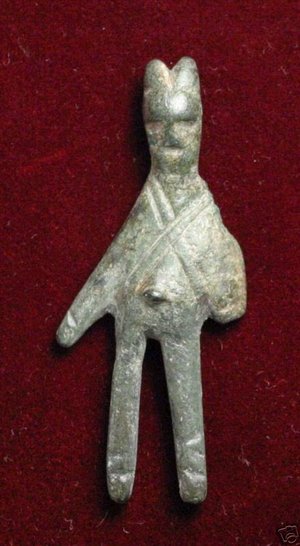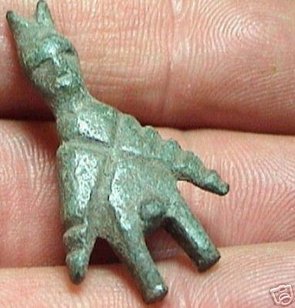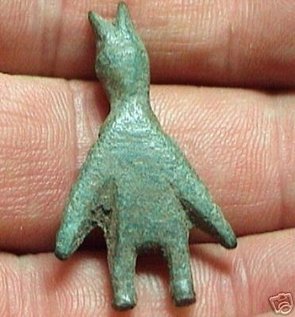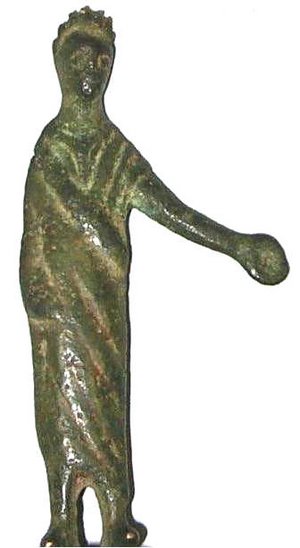
|
|

|

YOU ARE HERE:>>REAL or FAKE>>Is ths genuine, section3, page 5.
From Alvermanneke
4th October 07
Two statuettes of the Roman "wolf god" Faunus, the second of which I find suspect.
Two weeks ago I bought this statuette of Faunus:
It had been offered on eBay ("Buy now") for more than a month, priced at nearly 400 Euro (about 600 dollars), when it was suddenly auctioned and I was able to buy it for only 62 Euro (so, if it was not a bargain, it certainly wasn't a great loss either).
The object was offered with the following description (in German):
"Statuette eines Faunus, des Gottes der freien Natur und des Beschützers der Bauern und Hirten, ihres Viehs und ihrer Äcker. Faunus ist auch als Wolfsgott bekannt, hier dargestellt mit Wolfsohren, animalischen Gesichtszügen und Bocksfüßen. Die Darstellung ist nackt, über dem Oberkörper trägt er zwei kreuzförmig über der Brust getragene Riemen, die auch zu seinen Symbolen gehören. Das erigierte Glied weist ihn als Fruchtbarkeitsgott aus, der rechte Arm endet ebenfalls in einem Phallus. Höhe 4,3 cm. Römische Kaiserzeit, 1.- 4. Jhdt.n.Chr.; höchst interessante Darstellung, olivgrüne Patina
Zu den Festtagen des Faunus, den Lupercalien, wurden von den Priestern des Gottes Böcke geopfert und aus den Häuten Riemen geschnitten. Die Priester umrundeten dann den Palatin und schlugen die ihnen Entgegenkommenden mit den Riemen. Dies galt als Sühne- und Reinigsritual.
Faunus: bronze, heigth 4,3 cm, Roman Imperial, 1st to 4th cent. A.D."
It was sold by the eBay shop Kunst-der-Antike, AGORA,. Since this seller does not appear in the list of fraudsters and appears to have a genuine shop in Vienna, I believe he is 100% trustworthy.
Prior to bidding on the item, I send an email to the Geschäftsführer, with the following questions:
- Are you definitely sure that this is an image of Faunus? Do you know of other such finds described in the specialist literature? Or is this something unique?
- If it is Faunus, then what was the usage of the statuette? Since it looks quite primitive, do you think it was used as a kind of protective amulet, or was it perhaps a votive offering?
- Do you have more information on its provenance, the circumstances and the context of its discovery. Where was it discovered and how? Is it a metal detector find by an amateur? etc.
Promptly I received the following answer from him:
"I am sure, that this statuette depicts the roman good Faunus – you can also see the typical attributes, which no other Roman god has. I have seen in the past quite a few other Roman bronze figures like this one, on the antiquities market. They are always worked out in the same primitive way, and obviously come from the same factory. Usually, they are discovered in the southern part of Pannonia, in Hungary and Croatia. Probably, it was a votive-statuette, standing in a roman sanctuary. The item comes from an Austrian collection, built in the 50's. For that reason, I do not know the exact place where it was found."


Since I am currently doing research for a book on the ancient cultic tradition of the werewolf among the various Indo-European peoples in antiquity, I was very happy to acquire a genuine artefact, so I hoped, that bears testimony to that tradition among the Roman people. Actually, I am not a collector of antiquities, it is the meaning of the object that fascinates me, and I am certainly no expert, but I do care for authenticity and would be a little disappointed if this Faunus image turned out to be false
A few days ago my brother alerted me to a similar object, which had just been auctioned on eBay and which was sold for 168 Euro. The seller is a so called "Power seller", Elysium Ancients, who does not appear on the fraud list, but about whom I cannot find any information on eBay. Elysium Ancients sells mostly coins and appears not to know what the object is, for it was offered with the following vague description:
"A VERY UNUSUAL CELTIC/ ROMAN FIGURE NOT SURE WHICH IF ANY ONE HAS MORE INFORMATION I WOULD BE INTERESTED TO KNOW 3.7 CMS IN HEIGHT FOUND IN GERMANY AUTHENTICITY GUARANTEED AS WITH ALL MY ITEMS"
Here are the pictures that went with it:
Clearly it is once more a statuette of Faunus. However, there are two things about it I find particularly disconcerting:
- The casting seams to be very coarse indeed (for instance under the ears). Rough edges have not been filed away. That is especially evident, in the picture of the back of the statuette, under the left arm.
- The bands of goatskin crossed over the chest – called "Februa" in Latin, hence the name of the month Februari, when the festivities for Faunus were traditionally held – seem to have been filed into the body of the figure and do not lie on top of it, as they do with the first Faunus. Also the edges seem too sharp, without any traces of wear.
What are the odds for the appearance on eBay in such a short time frame of two statuettes of Faunus that are so alike? Is this only a coincidence? Are such objects perhaps not so rare as I thought? Are the striking similarities between the objects (the head with the wolf's ears and the heavy eye brows, the bands of goatskin, the long extended arms, the button like penis...) proof of their authenticity, or do these similarities mean something else? Acording to the seller these objects "are always worked out in the same primitive way, and obviously come from the same factory", but the first Faunus was on display on Ebay for quite some time and could have been forged quite easily.
My idea is that the first statuette is probably genuine (though I am not completely sure – for one thing, I have not been able to inspect it yet, since it is still in the mail somewhere between Austria and Belgium) and that the second is very likely a forgery. What do you experts think? Does any of you have first hand experience with such statuettes of Faunus? Are they all so similar to one another? Are they scarce or quite common? Can anyone send me references to articles in specialized magazines or photos of other images of Faunus of which the provenance can be established beyond all doubt? All relevant information would be most welcome. Many thanks in advance.

I can't see anything really obviously wrong with it.
As a probably votive object it cannot be rare....though I cant remember ever coming across one myself.
There is a similar one at The Staten Island Museum
Bronze; Etruscan, 4th-3rd century BCE.
MacDonald Bequest
These figurines represent Etruscan worshippers, holding phiales to pour libations to the gods. The figures wear crowns and togas, the latter garment an Etruscan legacy to Rome. These figurines were probably dedicated at an Etruscan sanctuary as ex-votos or offerings aimed at winning the help of a god or goddess.
From rialtos
5th October 07
I've seen these before and I've never been sure if it's some Celtic god or what. I've even seen it described (and possibly correctly) as a Romano-Celtic Mercury, with the strange "horns" being stylizations of the wings, and holding some abstraction of the caduceus. I'm just not sure who it is meant to be, nor am I sure which - if any - are ancient and which aren't. The fact that something is crudely executed with little or no wear doesn't bother me, especially if it's a votive piece that just sat in some shrine. The rough edges seem cause for concern, although not really conclusive in terms of fakery.


Home | About This Site | Privacy Statement | Gallery | Testimonials | Guarantees
About Collectors' Resources pages | What's New
Search | Site Map | Contact Us